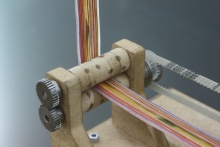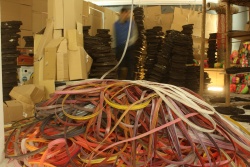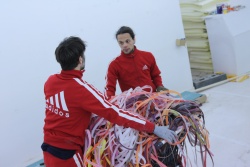DasBand: Unterschied zwischen den Versionen
Bilex (Diskussion | Beiträge) |
Bilex (Diskussion | Beiträge) |
||
| Zeile 33: | Zeile 33: | ||
===Motor & Gear=== | ===Motor & Gear=== | ||
First tests were made with a low-budget gearmotor found on ebay. Those are advertised with high torque rates. A closer look at the data sheet shows that sometimes these numbers are the stall values. That means: No rotation at given load. The required torque for proper operation was not known before and there was no clue how to calculate it. The motor not only needs to press the material through the pipe and the die, sometimes the drill needs to cut pellets on their way from the hopper inside the heating pipe. That means that the required power depends on the used material. The first test-material was a gift from the plastic | First tests were made with a low-budget gearmotor found on ebay. Those are advertised with high torque rates. A closer look at the data sheet shows that sometimes these numbers are the stall values. That means: No rotation at given load. The required torque for proper operation was not known before and there was no clue how to calculate it. The motor not only needs to press the material through the pipe and the die, sometimes the drill needs to cut pellets on their way from the hopper inside the heating pipe. That means that the required power depends on the used material. The first test-material was a gift from the plastic lab of the University Duisburg Essen. They gave us a whole 25kg bag for testing purpose. Unfortunately the material was not suitable for processing it in a selfmade-extruder due to its low [http://en.wikipedia.org/wiki/Melt_flow_index MFI] (Melt-flow-index) value. Even with very high temperatures the material did not become liquid as expected. Even without a die the first testing drivetrain nearly stalled. | ||
After that failure I met Helmut at the Labor. Helmut is a polymere expert. He advised me to try a PE with a higher MFI. He recommended me to contact a wellk-nown local plastic company. A few days later another 25kg PE bag with PE pellets inside arrived at the labor. (Amazing: PE pellets packed in a PE bag.) Again, this was a free sample but the material with the lowest MFI they had in stock. | After that failure I met Helmut at the Labor. Helmut is a polymere expert. He advised me to try a PE with a higher MFI. He recommended me to contact a wellk-nown local plastic company. A few days later another 25kg PE bag with PE pellets inside arrived at the labor. (Amazing: PE pellets packed in a PE bag.) Again, this was a free sample but the material with the lowest MFI they had in stock. | ||
Version vom 5. Januar 2013, 16:03 Uhr
| Das Band - Polyethylene Extruder Release status: stable [box doku] | |
|---|---|

| |
| Description | A Band making machine. |
| Author(s) | A.B. (Bilex) |
| Platform | Sophistication |
Information
Das Band is a multicolored LD-PE ribbon. It is flexible but durable, has a nice smooth surface and can be cut into pieces easily. This assures high adaptability in many thousand applications. It was manufactured within two weeks in line with the Big Banana factory.
Dimensions: 1,5mm x 15mm x ~250.000mm
Material: Riblene® MV10
Processing
The Extruder is the machine creating das Band. It works similar to those machines known from industrial production of plastic pipes, sheets and profiles. A turning screw (here: ordinary 20mm drill bit) takes plastic pellets from a feed hopper and squeeze them through a die. While in industrial machines the energy is provided by shear strain and high pressure, this machine works with an heating area where the pellets start to melt. After inserting energy into the material, it needs to be cooled down after leaving the die immediately to bring it into shape. (This loss of energy is a general problem during the extrusion process, even in industrial processing.) Several rotating rolls work as a shaping unit.
The Machine
Motor & Gear
First tests were made with a low-budget gearmotor found on ebay. Those are advertised with high torque rates. A closer look at the data sheet shows that sometimes these numbers are the stall values. That means: No rotation at given load. The required torque for proper operation was not known before and there was no clue how to calculate it. The motor not only needs to press the material through the pipe and the die, sometimes the drill needs to cut pellets on their way from the hopper inside the heating pipe. That means that the required power depends on the used material. The first test-material was a gift from the plastic lab of the University Duisburg Essen. They gave us a whole 25kg bag for testing purpose. Unfortunately the material was not suitable for processing it in a selfmade-extruder due to its low MFI (Melt-flow-index) value. Even with very high temperatures the material did not become liquid as expected. Even without a die the first testing drivetrain nearly stalled.
After that failure I met Helmut at the Labor. Helmut is a polymere expert. He advised me to try a PE with a higher MFI. He recommended me to contact a wellk-nown local plastic company. A few days later another 25kg PE bag with PE pellets inside arrived at the labor. (Amazing: PE pellets packed in a PE bag.) Again, this was a free sample but the material with the lowest MFI they had in stock.
Heating Unit
Die
Shaping Unit
Distribution
Video
Video on Youtube






